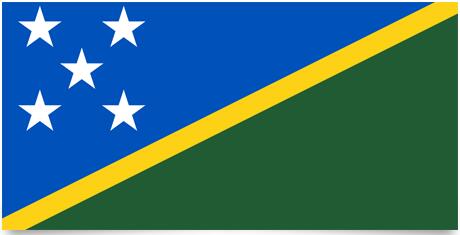Solomon Islands Flag and Meaning
Flag of Solomon Islands

Solomon Islands Flag Meaning
The blue color is a symbol of the sea, the green stands for the earth and the vegetation and the yellow line stands for the sun. The five white stars represent the largest archipelagos but are also reminiscent of the five administrative districts that the Salmon Islands consisted of when they became independent. The flag was adopted on November 18, 1977. The
trade flag is red, but a picture of the national flag makes up a quarter of the flag that is placed at the top against the inner edge of the flag. The war flag is white with a red cross and here too the national flag makes up a quarter of the flag which also has the same location as in the trade flag.
Solomon Islands Overview
| Population | 400000 |
| Currency | Solomon Island dollars |
| Area | 28,900 km² |
| Capital city | Honiara |
| Population density | 13.8 residents/km² |
| HDI location | 123 |
The Solomon Islands make up most of the islands of the same name, except for the northwest ones that belong to Papua New Guinea: the Ontong Java archipelago, the Rennell Islands and Santa Cruz. Solomon Islands is located in Melanesia east of New Guinea. The islands are of volcanic origin and the most important of them are the Guadalcanal (where the capital is also located), Malaita, Florida, New Georgia, Choiseul, Saint Isabel y St. Christopher. The landscape is mountainous and many hurricanes remain active. The economy continues to be based on fisheries and subsistence farming. At the same time, forestry means that one of the country’s most important resources is being used up. Violent rainfall causes erosion of the most exposed soils.
The People: The population is predominantly of Melanesian origin (93%); Polynesians (4%), Micronesians and small groups of Chinese and Europeans.
Religion: Anglicans 45%, Catholics 18%, Methodist and Presbyterian 12%, Baptists 9%, Pentecostal 7%. Other Protestants 5%, local traditional religions 4%.
Languages: English (officially, but only spoken by 1-2% of the population); “Pidgin” (local dialect derived from English) and a further over 120 dialects.
Political parties: National Unity and Reconciliation Group (formerly the People’s Alliance); People’s Alliance; Solomon’s National Action Party; Solomon’s Workers’ Party; the United Party.
Social organizations: Solomon Islands Trade Union Council (SICTU), formed in 1986 with 6 affiliated unions.
Official name: Solomon Islands.
Administrative subdivision: 8 provinces and the capital
Capital: Honiara, 68,000 residents (2003).
Other important cities: Gizo, 7,000 residents; Additionally, 5,000 residents; Kira Kira, 3,800 residents; Buala, 3,000 residents (2000)
Government: Frank Kabui, governor appointed by the British Crown in July 2009. Rick Houenipwela has been prime minister since November 2017. Parliament has 50 seats; the term of office is 4 years.
National Day: July 7 (Independence Day, 1978)













































